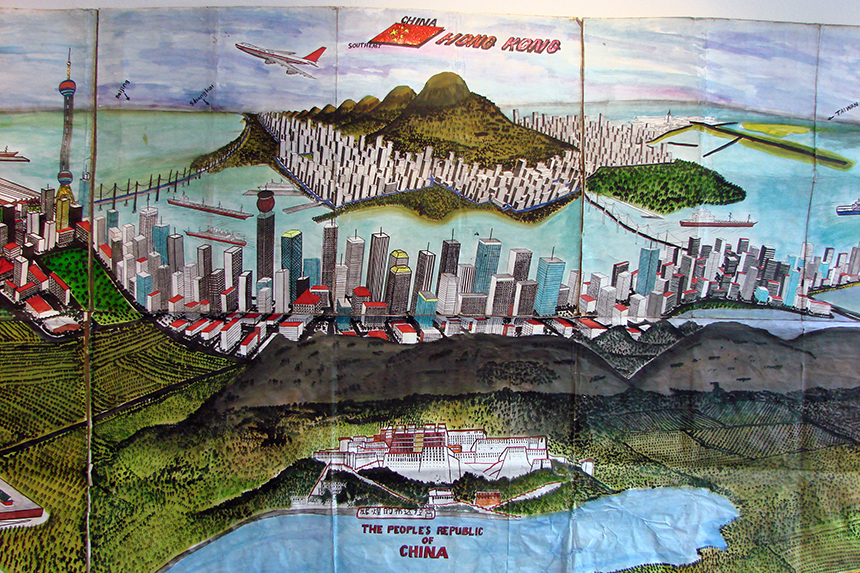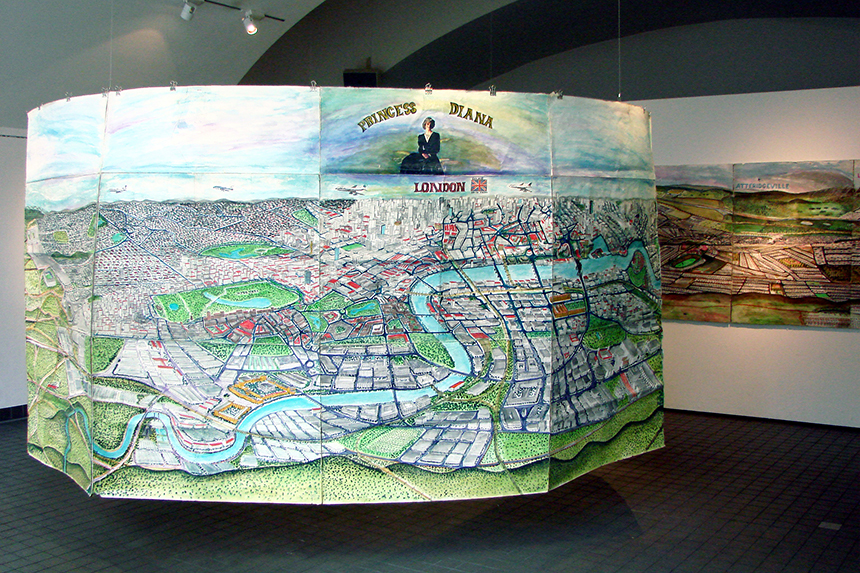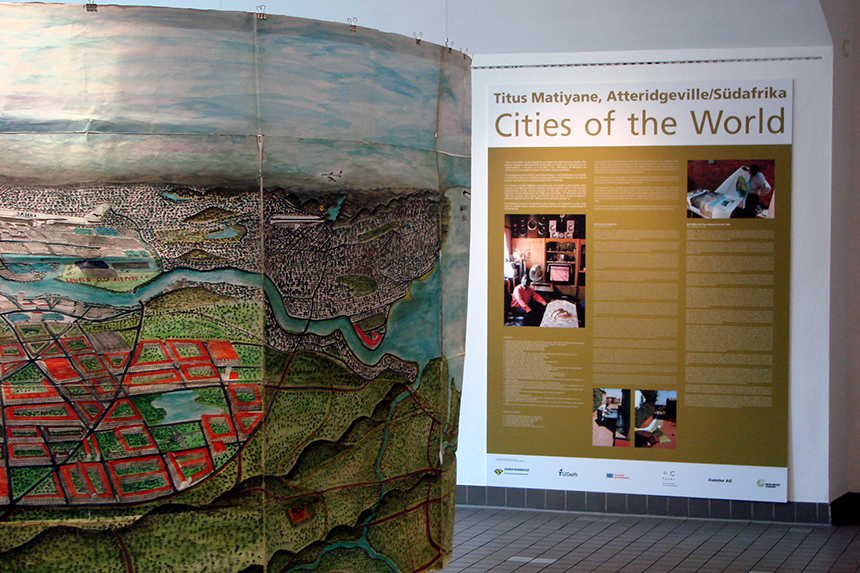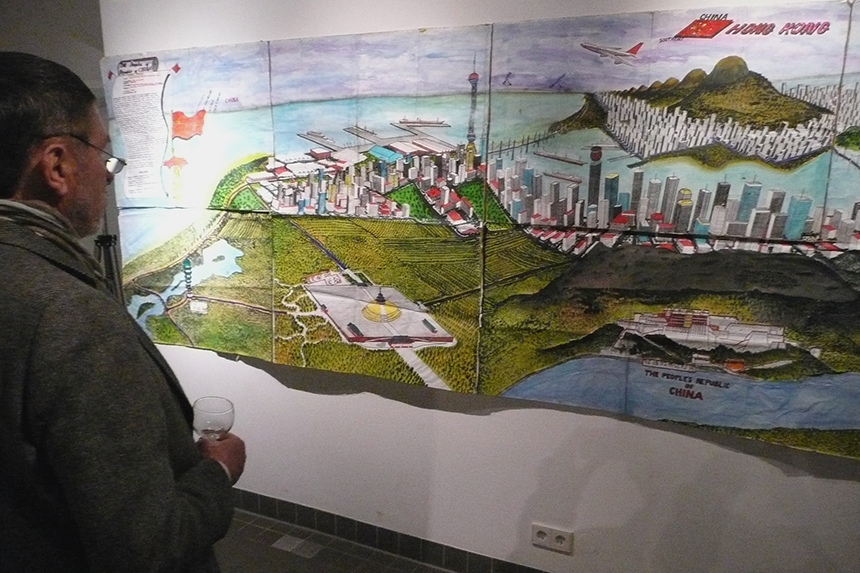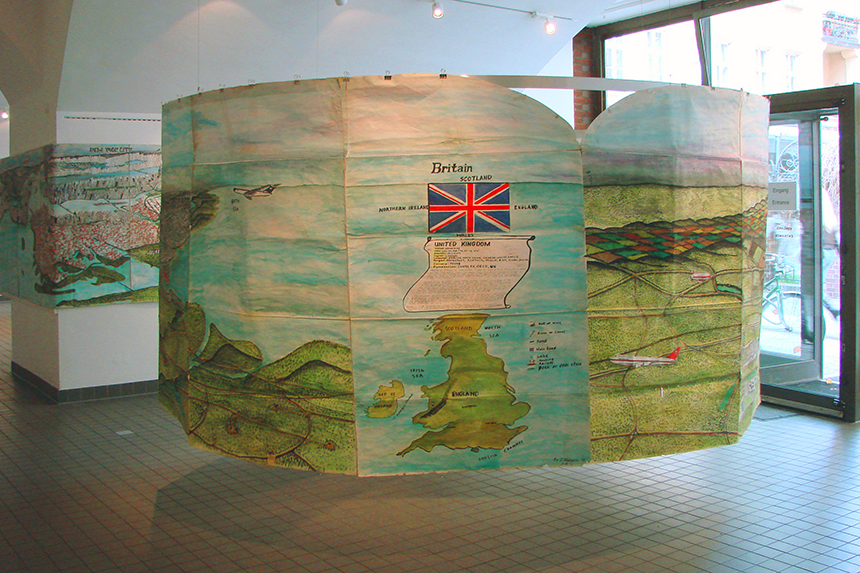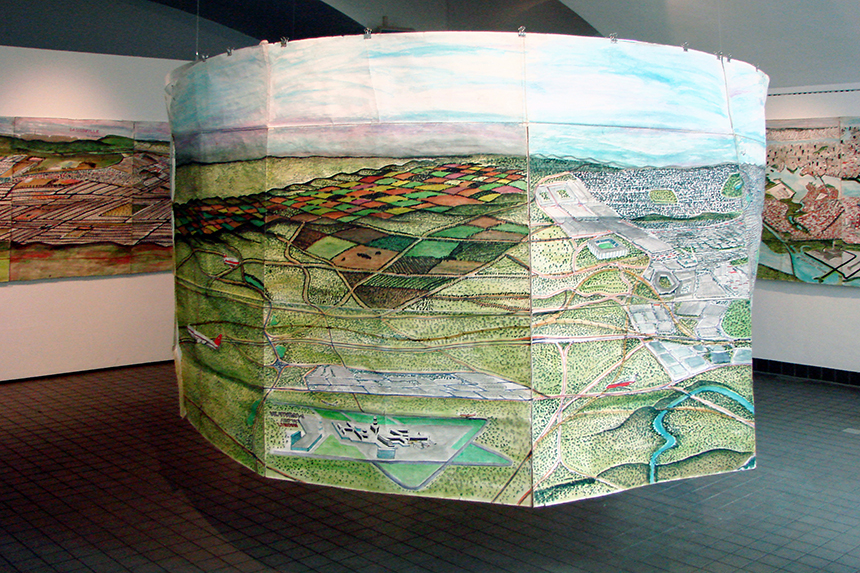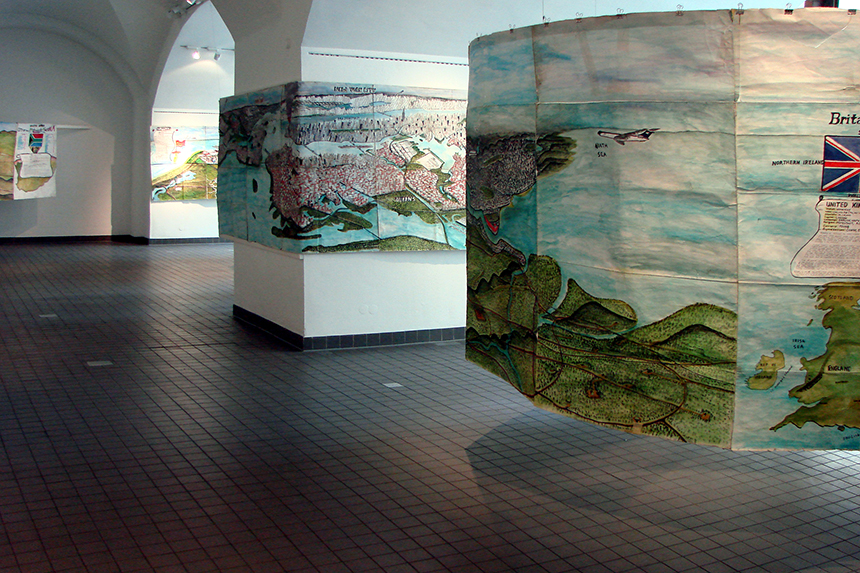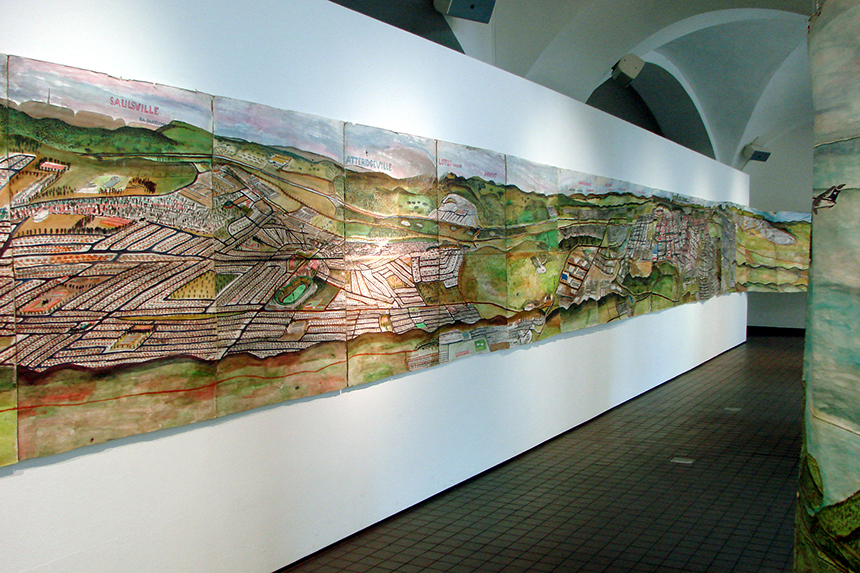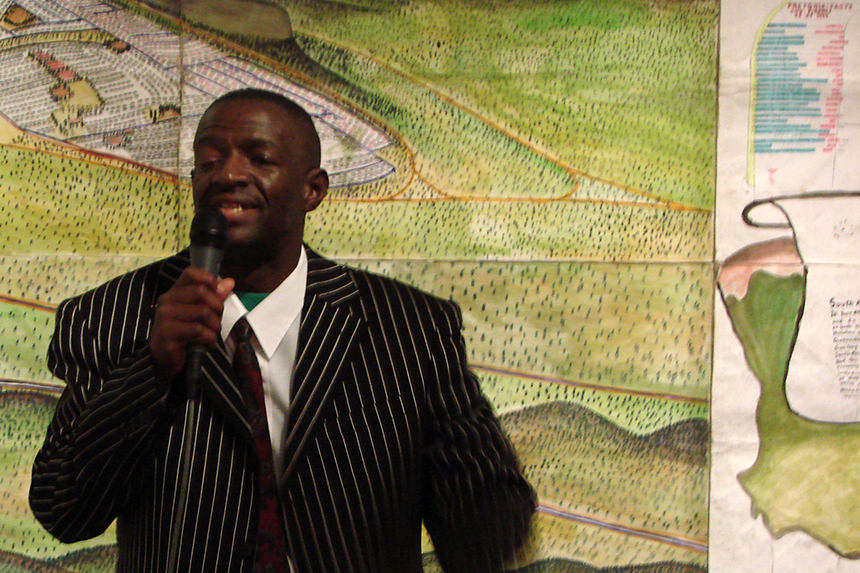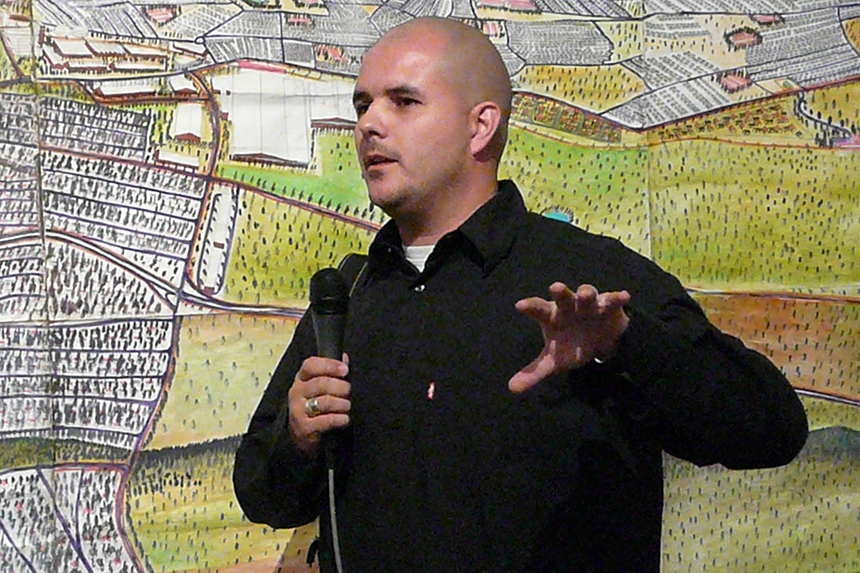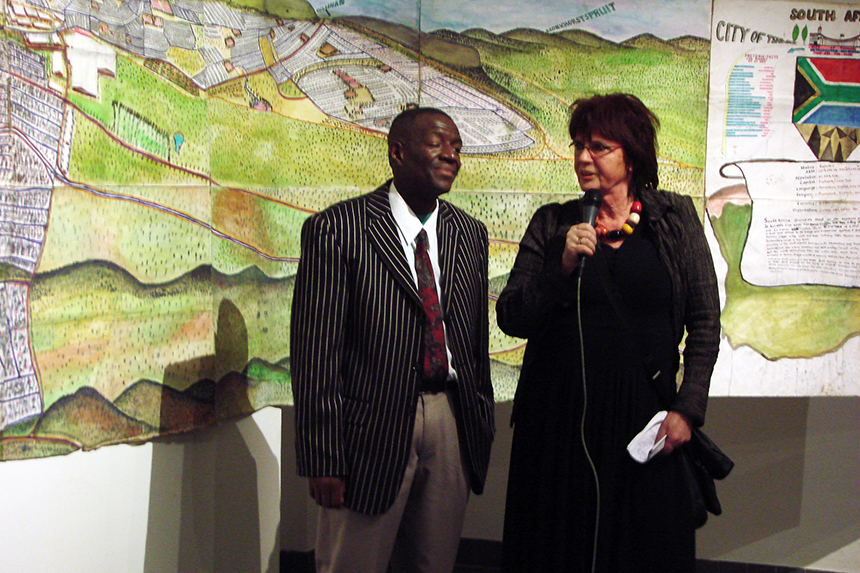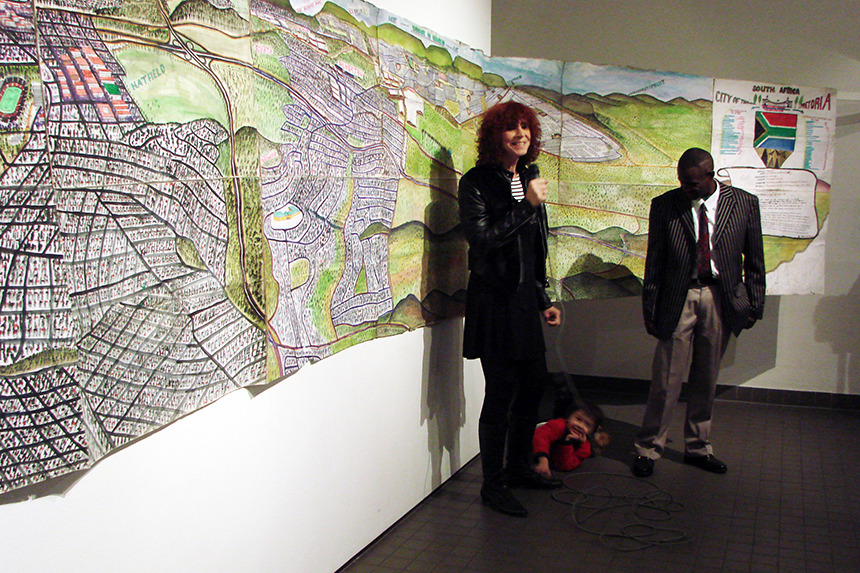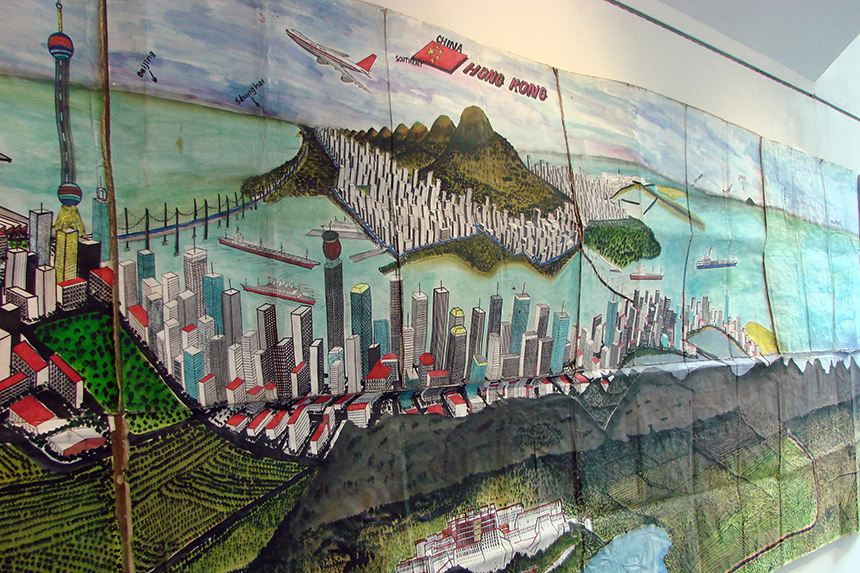‘Cities of the World’ is an exhibition of the work of South African artist Titus Matiyane. Matiyane creates huge panorama drawings of cities and landscapes from a bird’s-eye view. The colourful drawings, which vary in size from 6 to 46 by 1.5 metres, overwhelm viewers and take them on an extended journey through an urban landscape, which Matiyane depicts with a great sense of technique and visionary craftsmanship.
Titus Matiyane was already a part of ‘South African Season’s’, a manifestation on architecture and urban planning in South Africa, initiated by Kristin Feireiss, when she was director of the Netherlands Architecture Institute (NAI) in Rotterdam.
Titus Matiyane, artist, sculpture and musician, lives and works in Atteridgeville, a township near Pretoria, South Africa. Matiyane (1964) is one of many South African artists who have become fascinated by life in the townships and the growth, evolution and transformation of the cities. The panoramas, which he has been making since 1990, create the impression that the artist has observed the cities from the air, while in fact he only flew for the first time in 1998.
The exhibition contains five panoramas: of Durban and Pretoria in South Africa and of London, New York and Hong Kong. The exhibition has been put together by Annemieke de Kler, curator and producer from Rotterdam, and Stephen Hobbs, artist and partner of The Premises Gallery in Johannesburg. The exhibition will be opened on 9th February 2008. The accom-panying book ‘Titus Matiyane. Cities of the World’ is be published by Uitgeverij 010, Rotterdam. In the book, Melinda Silverman, an architect in Johannesburg, analyses the artist’s work from the perspective of architecture and urbanism, Stephen Hobbs describes Matiyane’s work from the context of art in South Africa and Annemieke de Kler sketches the artist’s background.
More information on Titus Matiyane Cities of the world and African Perspectives can be found on www.africanpersectives.nl.
Review copies of the book ‘Titus Matiyane. Cities of the world’ (ISBN 978 90 6450 640 6) can be obtained from Uitgeverij 010 by e-mail: [email protected] or by telephone: +31-(0)10-4333509
Meeting Titus Matiyane
By Annemieke de Kler Rotterdam
It is 12 March 1998, the day before the opening of South African Seasons, a manifestation on architecture and urban planning in South Africa, initiated by Kristin Feireiss, the (erstwhile) director of the Netherlands Architecture Institute (NAI) in Rotterdam. More than twenty exhibitions on this theme will be staged this year. The highlight is the exhibition entitled Blank_____Architecture, apartheid and after. Hilton Judin, an architect and philosopher from Cape Town, is the curator of this manifestation and exhibition, and I am the project manager.
We expect a great many South African architects and artists. The NAI is presenting the results of the Housing Generator, a design competition for social housing in South Africa organized by the Rotterdam Academy of Architecture and Urban Design, as well as the première of the film The Blacks Are Coming Back To Town which was produced by the Netherlands Interdenominational Broadcasting Station and features Rodney Harber, an architect from Durban. Works by the artists Stephen Hobbs, Roger Ballen and Santu Mofokeng will be on show elsewhere in Rotterdam.
The NAI entrance hall accommodates the installation entitled Home by Andries Botha, showing gripping texts from the Truth and Reconciliation Commission on lead panels. Not far from that, an impressive panorama drawing is on display: Johannesburg to Pretoria by the artist Titus Matiyane from Atteridgeville, a township near Pretoria. His CV indicates that he ‘has never flown in an aeroplane’, which is remarkable because Matiyane draws as if he is reproducing an aerial view, providing a survey of the landscape, the cities, the transport systems and aeroplanes. He presents his world on large sheets of paper. The work Johannesburg to Pretoria is an amazing 23 metres wide and 2.0 metres high. Soweto, Johannesburg and Pretoria are drawn with pen and painted in water colour, with a striking sense of scale and perspective, based on intuition and an admirable sense of detail.
At the end of the day, I receive our South African guests. I ask if they wish to do anything special to introduce their exhibition or project at the festive opening the next day. Titus Matiyane stands up and says, with a broad smile on his face, ‘I can sing’. He begins to sing and accompanies himself in an inimitable way, as if he is a one-man band. He uses his chest as a drum, the sound of a ... well, what is it, violin or trumpet? ... emanates from one corner of his mouth. Rhythmic sounds stem from the other. The South African national anthem resounds through the boardroom.
The official opening of South African Seasons is performed by the South African Minister of Housing, Sankie Mthembi-Mahanyele, and her Dutch counterpart Margaretha de Boer. An extra event has been inserted just prior to this: Titus Matiyane gives a many-voiced and multi-instrumental rendering of the national anthem ‘Nkosi Sikelel’iAfrika’. Later Sankie Mthembi-Mahanyele and Margaretha de Boer approach Matiyane’s drawing. Sankie Mthembi-Mahanyele recounts why Soweto lies so far from Johannesburg and points out the schools, the hospital, the taxi ranks, and some important places in the history of this township. Matiyane’s drawing brings the South African world of Soweto and Johannesburg closer and builds a bridge to the Netherlands. It is a world that we Europeans know from television pictures from the last few decades of the twentieth century: the incidents in Soweto, the popular uprising, and the military and police actions. But, even as late as 1998, had we ever seen a map of Soweto?
Chief Government Architect Wytze Patijn invites Titus Matiyane to participate in an excursion through the Dutch landscape to the south of Rotterdam. On his return, Matiyane says, while we walk back to the NAI together, ‘I am going to make a drawing, a big big drawing of Holland. From Rotterdam to Amsterdam I stare at him and he repeats: ‘Yes, I am going to make that drawing.’ I collect visual material for him. Wytze Patijn and Herman Meijer, the City Councillor for Urban Planning in Rotterdam, give him books with aerial photos of the Netherlands and Rotterdam. Matiyane is pleased to accept these, but mentions that the images in his head are sufficient for him to generate a good representation of the Dutch landscape and the cities.
Pretoria
It is April 5th, 1999 and I am in the Netherlands Embassy in Pretoria, my regular stop in South Africa when I come over to organize all the exhibitions. I discuss with Hans Glaubitz, the cultural attaché, the current issues concerning South African Seasons and Blank. Everything is going smoothly and we have time to spare because this time we don’t have to pay a joint visit to the Ministries of Arts and Culture and Housing. Glaubitz’s telephone rings and my attention begins to wander. I see a stack of photographs, held together by broad tape on the back, with the corners cropped. When I can no longer control my curiosity and lift the bundle, Hans remarks, ‘I almost forgot, Titus has finished his drawing. He dropped in and asked what I could do for him. We presented the drawing here in the African Window Museum when Tineke Netelenbos [erstwhile Minister of Transport and Public Works, AdK] came on a visit. Can you do anything with it?’ I unroll the stack of photos and discern a miniature panorama drawing of the Netherlands: from Rotterdam to Amsterdam. Although I have no idea of what to do with the photographs, I am delighted to take this mini-panorama back to the Netherlands.
‘Isn’t Atteridgeville close to Pretoria?’ I ask Hans, wondering if it would be possible to visit Matiyane. I know that it is not advisable to visit a township without an escort. There are no street signs, it is easy to get lost, and recently one of the South African photographers who had been shooting photos in a township for the Blank exhibition was robbed. Fortunately, the Embassy’s driver is available for this excursion. Glaubitz phoned Matiyane, who directed the driver to his house.
Titus Matiyane is waiting for us. We enter the living room via the kitchen and then move to the adjoining bedroom. The drawings are stored under the double bed. He gently pulls out the large rolls and carefully opens them up. First he shows Johannesburg to Pretoria, which had been on display in Rotterdam. Then comes New York – Manhattan, with the Twin Towers still intact – a drawing, which Matiyane altered after 9/11 to show the Twin Towers now on fire; and the Panorama of London. Matiyane, who makes a legend for his panoramas and places the head of state at the top of each drawing, comments: ‘I put Lady Diana there. She is greater than the Queen of England. It’s like in the Johannesburg panorama, where I have chosen to portray Nelson Mandela, as he is much more famous than Thabo Mbeki.’
Last but not least Rotterdam to Amsterdam appears. After the discovery of this panorama in mini-form earlier in the day, I can now see it in real life. Matiyane’s style is so distinctive. Although everything is exact and true-to-life, he never loses sight of the overall cohesion, testifying to a great degree of accuracy. Nevertheless, I am unable to gain a complete picture of the drawing; it is simply much too large for this room and this house.
The driver and I form an audience for an exclusive performance. Matiyane, the entertainer, singing in jazzy style, gives a rendering of the national anthems of South Africa, the USA, the UK, and the Netherlands. Matiyane's version of our anthem, ‘Wilhelmus’, is still under construction and misses some finishing touches. We take our leave. As we drive to Jan Smuts Airport, the driver, who had been particularly fascinated by Johannesburg-Pretoria – a route that he knows inside-out – draws my attention to places and details that he had seen on Titus Matiyane’s drawing.
CV
UNISA, Diploma for Architect (1989)
WORKING EXPERIENCE
CONSOL SPECIALIST GLASS (previously known as Consol Glass/Plastics)
50 Delfose Street
Pretoria West
Pretoria 0001
PERIOD: 1987 – 1997
POSITION: Quality control/ examiner of glass
CONTACT: Mike Moloto (Personal Manager)
(012) 3272185
(012) 3188865
GALLERIES EXHIBITED
• PRETORIA ART MUSEUM: 1984. Models. Article in Beeld by Piet Muller. 1985 Article in SA Today: Makorakora: Shaping wire into vehicles, featuring photograph of model of spacecraft “Challenger” made by artist.
• AFRICANA MUSEUM: 1985. Concord model, sponsored by BMW.
• DURBAN ART MUSEUM: 1985. Models, including concord.
• SA NATIONAL ART GALLERY: 1986. Exhibition of all models.
• UNISA ART GELLERY: 1992.
• GRAHAMSTOWN ART FESTIVAL: 1992. Panorama of Pretoria. Workshops on models, sponsored by Transnet.
• JOHANNESBURG ART GALLERY: 1993. Attridgeville Panorama
• TOTAL GALLERY: 1993. Pretoria panorama, sponsored by TV-BOB.
• NEW TOWN GALLERY: 1995: Panorama of Western Cape.
• GRAAFF REINET ART GALLERY: 1995. Exhibition of small works, mainly portraits.
• GRANDSWELL ART GALLERY, UK: 1996. Panorama of Pretoria.
• GOODMAN GALLERY: 1996. Exhibition of models, Boeing727 and 747
• EARTH AND EVERYTHING, UK: 1996. Panorama of Pretoria and models. Sponsored by the Council of Wales. Recommendation by Dr Lydia de Waal, director of Museums and Cultural Development.
• REMBRANDT VAN RIJN ART GALLERY: 1997. Panorama of Gauteng.
• AFRICAN WINDOW: 1998. Panorama of the Netherlands. The Royal Netherlands Embassy.
• NETHERLANDS ARCHITECTURE INSTITUTE, Netherlands: 1998. Panorama of Johannesburg.
• SA INSTITUTE OF ARTISTS AND DESIGNERS: 1998. Panorama of Gauteng.
• KEMPTON PARK TEMBISA METROPOLITAN LOCAL COUNCIL: 1999. Panorama of London. Landscape of Gauteng. Top-100 Fine arts award.
• MARKET THEATRE GALLERY: 1999. Sponsored by the TRC: Commissioning the Past.
• BANG THE GALLERY (CT): 2000. Sponsored by Hewlett-Packard: Painting a Printer: Artist brief to create artwork of one of their range printers. Work was auctioned and exhibited at gala event in Johannesburg.
• CULTURE AND RECREATION OF PRETORIA: 2000. Panorama of Pretoria sponsored by the City Council of Pretoria AND Sammy Marks Museum.
• NETHERLANDS ARCHITECTURAL INSTITUTE, Netherlands: 2000. Panorama of Netherlands
• ART ON PAPER: 2001.
• MUSEUM AFRICA, Witwatersrand: 2001
• SA EMBASSY, in Japan. 2001. Panorama of Pretoria 2001, incomplete version (7 meters); Complete version is 18,5 meters, and includes Mamelodi and Attridgeville.
• UNISA ART GALLERY: 2002. Fringe Exhibition of Land art exhibition, including aerial views of Maseru, London and New York.
• Panoramic view of the city centre of Pretoria from Muckleneukrant, Pretoria (2006). W& J van Zyl Commission.
WORKSHOPS AND TEACHING
• PRETORIA TECHNIKON: 1984. Workshops and Exhibition.
• CAPE TOWN UNIVERSITY: 1991. First National Sculpture Symposium. Demonstration.
• DURBAN UNIVERSITY: 1992. Demonstration and exhibition.
• WITS UNIVERSITY: 1993. Demonstration. Article in University Galleries by Elizabeth Rankin.
• TECHNIKON OF NATAL: 1993. Teaching Workshop.
• PIETERSBURG CIVIC THEATRE: 1998. HSRC Yeast Exhibition. Demonstration
• PRETORIA UNIVERSITY: Demonstration and workshop. Motivated by Anita Storck.
WORKS SOLD
• Western Cape Panorama (1985). Mixed media on paper, 4m. Sold to Newtown Gallery. Models of trains, busses, airplanes, cars (1985). Sold to Cape Town University and SA National Gallery.
• Attridgeville Panorama (1990). Mixed media on paper, 6m. Sold to University of Cape Town.
• Witwatersrand (1992). Sold to Museum Africa in 2001.
• Grahamstown Panorama (1995). Mixed media on paper, 4m. Sold to WITS University.
• Panorama of Pretoria (city only) (1995). Mixed media on paper, 3m. Sold to National Cultural History Museum.
• Panorama of Pretoria (1996). Mixed media on paper, 12m. Sold to Groundswell Gallery, London.
• Panorama of Attridgeville (1999). Mixed media on paper, 3m. Sold to The Bang Gallery.
• Panorama of Gauteng (2001). Mixed media on paper, 23m. Sold to Melville Art Centre.
• Panorama of the Netherlands Rotterdam - Amsterdam (2000). Mixed media on paper, 22m. Sold to Netherlands Architecture Institute, Annemieke de Kler (Director: Kristen Feireiss). Since end of 2000: owned by Wytze Patijn. Mentioned in Images of Metal: Post War Sculptures and Assemblages in South Africa, by Prof Liz Rankin.
• Pretoria from Attridgeville to Mamelodi (2003). Mixed media on paper, 18m. Spier Commission.
MENTION IN PUBLICATIONS
Rankin, E. Images of metal: Post-war sculptures and Assemblages in South Africa.
WORKS STILL AVAILABLE
Limpopo Province (2004). Mixed media on paper, 48m.
Panorama of Pretoria (2003). Mixed media on paper, 18m
Kwazulu Natal (2005). Mixed media on paper, 8m
China (2005). Mixed media on paper, 18m
Lesotho (1998). Mixed media on paper, 5m
Panorama of Cape Town (2005). Mixed media on paper, 7m
In the words of Gavin Young (Lecturer at Fine Arts Department, University of Cape Town):
Matiyane works from what I have called his available reality. Although his work is strongly influenced by the uniquely uninspiring elements of municipal townships, his imagination has also been caught by the most available reality of all – the world of advertisements. If popular histories of art proceed by way of ages, then today is the age of the advertising image.
To many black artists, the process of modernisation appears to hold out the promise of emancipation from white domination. The highly controlled forms of association found in the townships have shaped Matiyane’s horizon.
Matiyane has never studied art and has not picked up its mannerisms, nor has he understood its mechanisms of approval. His first patrons were his school friends. Later, his singular skill in procuring and working scrap metal led to his work being featured in numerous newspaper and magazine articles. Despite this attention, he only came to the attention of art critics when his two-meter long model of a British Airways Concorde was included on the BMW sponsored Tributaries exhibition which toured West Germany.
Diese Ausstellung wurde ermöglicht mit der großzügigen Unterstützung von:





